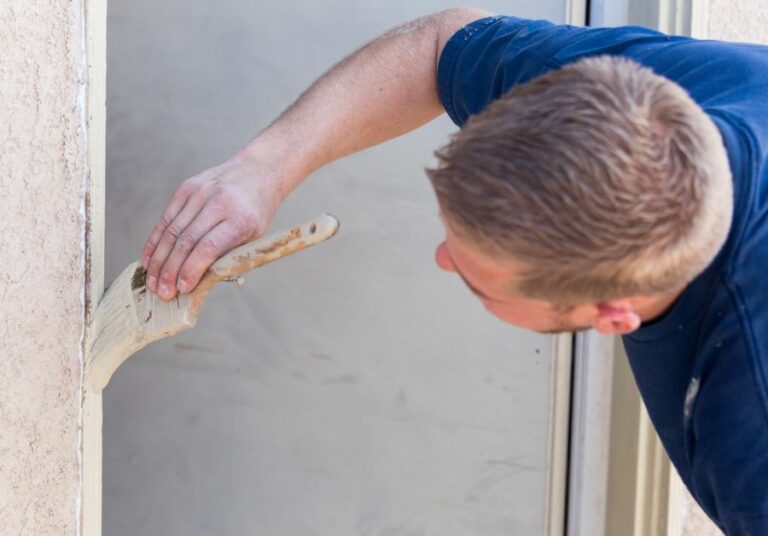Outdoor Paint Booth, 25 Things You Should Know
As an artist or a DIY enthusiast, creating an outdoor paint booth is the perfect way to achieve professional results while enjoying the benefits of working outdoors. Let’s dive into outdoor paint booths, explaining how to design, assemble, and use one effectively. Say goodbye to paint fumes in your garage or basement!
Outdoor paint booth:
An outdoor paint booth offers enhanced productivity, improved safety, and compliance with environmental regulations in a dedicated, controlled environment for painting operations. It minimizes dust, debris, and airborne contaminants, ensures the proper disposal of paint waste, and provides efficient ventilation systems to reduce VOCs, fire, and explosion risks. When choosing the right booth, consider size, filtration, ventilation, durability, and ease of use to optimize productivity, safety, and environmental impact.

Discover the benefits of an outdoor paint booth, unravel the essential components to set one up, and learn valuable tips to maintain air quality and safety. Maximize your project’s outcome while enjoying the luxury of painting in nature.
Contents
- 1 Exterior Painting Booth
- 2 Is it Possible to Install a Paint Booth Outdoors?
- 3 Is a Paint Booth Truly Necessary for Your Operations?
- 4 What is the Process for Creating Outdoor Spray Paint Booths?
- 5 What is the National Fire Protection Association (NFPA) code applicable to paint booths?
Exterior Painting Booth
• Enhanced Productivity
An outdoor paint booth provides an optimal environment for painting, ensuring that the paintwork is perfect every time. The controlled environment minimizes dust, debris, and airborne contaminants. This results in a smoother, cleaner, and more professional-looking finish.
In addition to creating a cleaner environment for painting, outdoor paint booths also provide a dedicated space for painting operations. This allows painters to work more efficiently, maintain their focus, and produce a higher volume of work. Furthermore, the controlled environment can help reduce paint waste, as overspray is more easily contained within the booth.
• Improved Safety
Outdoor paint booths are designed with safety in mind, providing a controlled and well-ventilated environment for painters. Proper ventilation ensures that harmful fumes, including volatile organic compounds (VOCs), are removed from the workspace. This improves air quality and minimizes the risk of fire and explosion.
Also, paint booths have numerous safety features, such as fire suppression systems and emergency shut-offs. These features help protect the painter, as well as the equipment and can help prevent catastrophic accidents from occurring.
• Compliance with Environmental Regulations
Outdoor paint booth systems are specifically designed to comply with environmental regulations, making it easier for businesses to adhere to these necessary standards.
With the proper filtration and ventilation systems in place, outdoor paint booths can help minimize the impact of paint operations on the environment.
By capturing and containing paint overspray, outdoor paint booths can reduce air pollution and improve overall air quality. Additionally, these systems can aid in the proper disposal of paint waste, ensuring that hazardous materials do not end up in landfills or water sources.
• Key Considerations for Choosing the Right Outdoor Paint Booth
– Size and Space
When deciding on an outdoor paint booth, it’s important to consider the size and space requirements of your painting projects. The booth should be large enough to accommodate the items you’ll be painting and any equipment you’ll need access to during the process.
Be sure to account for necessary space around the booth as well, taking into consideration factors such as ventilation, safety zones, and access for maintenance and cleaning.
– Filtration and Ventilation Systems
Proper filtration and ventilation are essential for both safety and environmental compliance. Make sure to choose an outdoor paint booth that offers appropriate systems to maintain air quality and remove hazardous fumes.
I recommend a booth equipped with a multi-stage filtration system that effectively captures and removes paint particles and a downdraft or semi-downdraft ventilation system to ensure that fumes are efficiently expelled from the workspace.
– Durability and Construction
Investing in a high-quality, durable outdoor paint booth is smart, as it will likely withstand the elements and provide years of reliable service. Opt for a booth with robust construction, such as heavy-duty steel panels and corrosion-resistant materials.
– Ease of Use and Maintenance
An outdoor paint booth should be both user-friendly and easy to maintain. Look for features that make the booth easy to clean, such as smooth interior surfaces and easily accessible filters.
Additionally, consider investing in a booth with advanced lighting and control systems to improve visibility and facilitate effortless operation.
• In Conclusion
An outdoor paint booth is an invaluable asset for any business that requires a dedicated, controlled environment for paint operations. With improved productivity, safety, and environmental compliance, an outdoor paint booth can prove to be a valuable investment for businesses of all sizes and industries.
Remember to consider factors such as size, filtration, ventilation, durability, and ease of use when selecting the ideal outdoor paint booth to meet your specific needs.
By investing in a high-quality outdoor paint booth, you can ensure a safer and more productive workspace, better paint finishes, and reduced environmental impact, all significant benefits that can enhance your business operations and improve your bottom line.
Is it Possible to Install a Paint Booth Outdoors?
The question of whether or not you can install a paint booth outside is one that comes up quite often, especially for businesses and individuals who may not have the luxury of ample indoor space to accommodate such equipment.
The answer is yes, you can indeed set up a paint booth outside, provided that you take certain factors into consideration and follow the necessary guidelines.
• Benefits of an Outdoor Paint Booth
Before discussing the requirements and recommendations for setting up an outdoor paint booth, it is worth highlighting some key benefits of choosing this option:
- Space-saving: One of the most obvious reasons is the conservation of indoor space, especially for businesses with limited workshop or warehouse areas.
- Ventilation: Setting up a paint booth outdoors can provide better ventilation, ensuring that fumes dissipate quickly and reducing the risk of harmful exposure to volatile organic compounds (VOCs) and chemical odors.
- Temperature control: In regions with favorable weather conditions, an outdoor paint booth can be easier to maintain at the recommended operating temperature compared to an indoor setup, which might require additional heating or cooling systems.
• Outdoor Paint Booth Requirements
When setting up an outdoor paint booth, certain requirements must be met to ensure safety and environmental regulations compliance. These include:
– Adequate Protection from the Elements
Even though your paint booth will be outdoors, you must provide a protective structure, such as a canopy or overhead roofing, to shield the booth from rain, snow, and direct sunlight.
While some may argue that a simple tent would suffice, investing in a more durable, weather-resistant structure is best to guarantee longer-lasting protection for your paint booth.
– Proper Ventilation
While the outdoor setting naturally provides better ventilation by default, you still need to ensure that your paint booth has a proper air supply and good-quality exhaust systems to control fumes and chemical odors effectively.
The exhaust system should also have appropriate filtration equipment to trap and remove airborne pollutants, as environmental and safety regulations require.
– Compliance with Local Regulations
Before setting up a paint booth outdoors, check with your local government and environmental agencies to ensure you meet all the regulations, requirements, and permits applicable in your region.
This may vary depending on location, and ignoring these regulations may result in fines or legal consequences.
• Additional Recommendations
While the above requirements form the foundation of setting up an outdoor paint booth, here are some additional recommendations based on my experience:
– Select a Suitable Location
When evaluating where to place your paint booth, consider the proximity to other buildings, equipment, activities, and prevailing wind patterns.
This will help minimize the chances of paint overspray, fumes, or dust affecting neighboring areas and also ensure that your paint booth operates efficiently without excessive interference from the surroundings.
– Invest in a High-Quality Paint Booth
Choose a paint booth manufactured from durable materials and designed to withstand harsh weather conditions. A well-built paint booth will comply with safety regulations and last longer, giving you better value for your money.
– Regular Maintenance and Inspection
Scheduled maintenance and inspections are crucial to keeping your paint booth in optimal working condition. This includes cleaning filters, checking air supply and exhaust systems, and inspecting the structural integrity of the booth and its protective structure.
– Train Your Staff
Ensure that your staff is well-trained in the proper use and maintenance of the paint booth, as well as safety procedures, including the use of personal protective equipment such as respirators and safety goggles.
• Conclusion
In summary, setting up a paint booth outdoors is viable, offering several benefits such as better ventilation, space-saving, and potentially easier temperature control.
However, it is crucial to take necessary precautions, abide by safety and environmental regulations, and invest in high-quality equipment and adequate protection for the paint booth.
By following the guidelines and recommendations shared in this article, you can ensure your outdoor paint booth’s safe and efficient operation.
Question | Answer |
|---|---|
Can you put a paint booth outside? | Yes, but it is important to consider factors such as local regulations, weather conditions, and proper ventilation when placing a paint booth outside. |
Is a Paint Booth Truly Necessary for Your Operations?
As an experienced painter, the question “Do you really need a paint booth?” is something I come across quite often. While paint booths can be quite beneficial for both small and large-scale projects, there are factors to consider before deciding whether it is the right investment for you.
• Advantages of Using a Paint Booth
– Enhanced Safety and Health
One of the primary reasons for using a paint booth is to ensure a safe and healthy environment for those working with paint or coatings. A paint booth provides good ventilation, ensuring that harmful fumes and dust are extracted and clean, filtered air is recirculated into the workspace.
This greatly reduces the risk of occupational hazards associated with paint fumes and particulates.
– Improved Paint Quality and Finish
A paint booth allows you to work in a controlled environment, minimizing external factors that can affect the quality of the paint job. Dust and debris are filtered out, reducing the chances of imperfections on the painted surface.
Additionally, a well-maintained paint booth can help control humidity and temperature, ensuring that the paint dries evenly and adheres to the surface.
– Increased Productivity and Efficiency
Painters are less likely to be distracted by their surroundings when working in a paint booth, leading to increased focus and productivity. The controlled environment also allows for accurate estimates of drying times, preventing potential delays due to weather conditions.
Furthermore, when working with potentially hazardous materials, a paint booth can save time by negating the need for additional safety precautions.
• Disadvantages of Using a Paint Booth
– Initial Investment and Operating Costs
The cost of installing and operating a paint booth can be quite significant, particularly for small businesses. Initial costs include buying the equipment, site preparation, and installation. Operating costs comprise energy, maintenance, and filter or exhaust system expenses.
It is important to weigh the long-term benefits against the initial investment before deciding to install a paint booth.
– Space Requirements
A paint booth can take up significant space, and proper planning is necessary to ensure it does not disrupt the workflow. Consider the size of your projects and the type of booth that is most suitable for your specific needs.
The paint booth should be strategically placed to allow for easy movement of materials in and out of the booth and accommodate your workspace layout.
• Types of Paint Booths
– Open Face Paint Booths
Open face paint booths are the simplest type and are often the most budget-friendly option. They contain an open front and three enclosed walls, allowing for easy access to the painting area.
These booths are suitable for small-scale projects or operations that don’t require the level of control offered by other types of booths.
– Closed or Enclosed Paint Booths
Enclosed paint booths are completely contained with access through doors, providing a more controlled environment for painting. These booths are ideal for operations that require precision and superior paint finish quality, such as automotive or aerospace painting.
– Pressurized Paint Booths
Pressurized paint booths have a positive air pressure inside the cabin, preventing dust and debris from entering the workspace. This type of booth provides the highest level of control and is ideal for applications where a clean environment is essential, such as electronics or medical equipment painting.
• Importance of Proper Maintenance
Regular maintenance is essential for a paint booth’s safe and efficient operation. It ensures that your booth continues to provide a clean, controlled environment that meets industry standards. This includes changing filters, checking the exhaust system, and ensuring all components function properly.
Regular maintenance also extends the lifespan of your paint booth, offering a better return on investment.
• Final Thoughts: Do You Really Need a Paint Booth?
Ultimately, the decision to invest in a paint booth comes down to the type of work you do, the scale of your projects, and the level of control you require in your painting process.
If you deal with hazardous materials, require a high-quality finish, or work in an industry with strict regulations, a paint booth is a necessary investment.
However, if you only handle small-scale projects and do not require as much control over your painting environment, you may be able to manage without a paint booth. In this case, focus on implementing proper safety precautions and keep your workspace as clean as possible.
For those still unsure, I highly recommend visiting other painting operations to see different types of booths in action before making a final decision. This will allow you to understand better the benefits and limitations of various paint booth options and make an informed decision based on your unique requirements.
Factors to Consider | Why It’s Important |
|---|---|
Workspace size | A paint booth can reduce the risk of overspray affecting other areas of your workspace. |
Air quality | A paint booth can improve air quality by reducing harmful emissions from paint and solvents. |
Worker safety | A paint booth can protect workers from inhaling paint fumes and provide a controlled environment for painting. |
Paint quality | A paint booth can provide a dust-free environment, resulting in a cleaner and more professional paint finish. |
Regulations compliance | A paint booth may be required by local or government regulations regarding emissions and worker safety. |
What is the Process for Creating Outdoor Spray Paint Booths?
As an experienced spray painter, I’ve realized that having an outdoor spray paint booth is essential for achieving professional results. It provides a clean, controlled environment where you can produce high-quality paint finishes without the worry of dust and other air contaminants.
• Choose a Suitable Location for Your Spray Paint Booth
Selecting the right location for your outdoor spray paint booth is important to ensure proper airflow and minimize the effects of environmental factors such as wind or moisture. Here are some key considerations when choosing your booth’s location:
- Sheltered Area: Choose a site that is protected from extreme weather conditions such as direct sunlight, heavy rain, or strong winds. This can be achieved by positioning your booth under a canopy, tent, or other temporary shelter, which can help protect it from external elements.
- Level Ground: Make sure the surface is flat and level to ensure stability and reduce any risks of deformation when constructing your spray paint booth.
- Safe Distance: It’s essential to keep the spray paint booth at a safe distance from your home or any other structures to prevent potential fire hazards.
• Designing Your Outdoor Spray Paint Booth
There isn’t a one-size-fits-all solution when it comes to designing an outdoor spray paint booth. However, there are some factors to consider, which include:
– Size and Dimensions
Consider the size and dimensions of the objects you plan to paint, and allow for enough space to maneuver around them comfortably.
Your spray paint booth should be large enough to accommodate the biggest items you plan to paint and some additional space for proper air circulation and equipment storage.
– Materials
Strong yet lightweight materials are ideal for constructing your outdoor spray paint booth. PVC pipes and plastic sheeting are popular choices due to their affordability and ease of assembly. Additionally, these materials are easy to maintain and can be easily disassembled for storage when not in use.
– Ventilation
Proper ventilation is crucial for any spray paint booth. It helps remove paint fumes and overspray, ensuring a safe and clean work environment. Consider incorporating the following features:
- Exhaust Fan: An exhaust fan positioned at the back of your booth helps draw air through the booth and expel fumes and particles outdoors. Ensure the fan has adequate airflow and is explosion-proof to avoid potential hazards.
- Air Intake Filter: An air intake filter at the front of the booth can help filter the incoming air, removing dust and contamination that can compromise the quality of the paint finish.
- Exhaust Filters: Installing exhaust filters behind the exhaust fan can help catch any remaining paint particles before they’re expelled into the environment.
• Constructing Your Outdoor Spray Paint Booth
Now that you have considered your booth’s size, materials, and ventilation, it’s time to construct it. I recommend following these steps:
- Build the Frame: Begin by constructing a frame using PVC pipes or other lightweight materials. Secure the frame with adjustable clips or pipe clamps to ensure its stability.
- Add the Walls and Ceiling: Attach plastic sheeting or other lightweight materials to the frame’s sides and top to create walls and a ceiling. Be sure to leave openings for the air intake and exhaust fan.
- Install Ventilation: Attach the exhaust fan to the opening at the back of the booth, ensuring it’s positioned correctly and securely fastened. Install the air intake filter and exhaust filters according to the manufacturer’s instructions.
- Secure the Paint Booth: Use heavy-duty stakes or weights to secure the bottom of the paint booth to the ground. This will help prevent the booth from shifting or collapsing during use.
- Add Lighting: Adequate lighting is essential for a quality paint job. Consider adding portable work lights or LED strip lights to your booth to ensure proper visibility.
• Usage and Safety Recommendations
Once your outdoor spray paint booth is set up, keep the following tips in mind for safe and efficient operation:
- Always wear personal protective equipment (PPE) such as goggles, gloves, and a respirator when working with spray paint.
- Dispose of paint waste and used filters according to local regulations and guidelines.
- Keep flammable materials and substances away from the spray paint booth to avoid potential fire hazards.
- Always follow the manufacturer’s instructions for your spray paint products and equipment.
• Conclusion
An outdoor spray paint booth can be an invaluable addition to your painting toolkit, offering a controlled environment that helps you achieve professional results.
By following the guidelines and recommendations, you’ll be well on your way to constructing an outdoor spray paint booth that serves your needs and ensures a safe and efficient painting process.
Step | Description |
|---|---|
1 | Select a location for the outdoor spray paint booth that is well-ventilated and far from open flames or sparks. |
2 | Measure and plan the size of the booth, ensuring it’s large enough to accommodate the items you will be painting. |
3 | Build the booth frame using PVC pipes, 2x4s, or other suitable materials. Secure the frame using screws or pipe connectors. |
4 | Cover the booth frame with plastic sheeting or tarps, leaving one side open for easy access. Secure the coverings with zip ties, duct tape, or clamps. |
5 | Create a ventilation system by installing box fans in the booth’s open side. Position the fans to blow air out of the booth, away from you and the painted objects. |
6 | Set up a work table or hanging system inside the booth to hold the items you will be painting. |
7 | Wear a respirator and other protective gear while using the spray paint booth. |
8 | Clean the booth and replace the plastic sheeting or tarps as needed. |
What is the National Fire Protection Association (NFPA) code applicable to paint booths?
• Introduction to NFPA
The National Fire Protection Association (NFPA) is a global nonprofit organization that works to eliminate death, injury, property, and economic loss due to fire, electrical, and other related hazards.
To achieve this, the association establishes codes and standards, provides training and education, advocates for public policy changes, and conducts extensive research.
One such code, and the subject of this article, focuses on the safety requirements for paint booths. The NFPA code for paint booths is found within the NFPA 33: Standard for Spray Application Using Flammable or Combustible Materials.
• Overview of NFPA 33
NFPA 33 was specifically designed to safeguard individuals and properties from fire and explosion hazards that may arise during the spray application of flammable or combustible materials.
Although it is predominantly focused on paint booths, this code also applies to other areas where such materials are sprayed, including spray areas, spray rooms, and spray enclosures.
The code contains a set of guidelines and requirements for the design, construction, and operation of paint booths. Compliance with NFPA 33 helps protect businesses, employees, and facilities against the potential dangers of paint spraying processes.
• Key Elements of NFPA 33
– Paint Booth Design and Construction
According to NFPA 33, paint booths must be designed and constructed to contain and control potential hazards associated with the spray application of flammable and combustible materials. There are several requirements that paint booths must meet, including:
- Materials: To minimize fire risks, the paint booth’s walls, ceilings, and floors should be made of noncombustible materials.
- Ventilation: Proper airflow is critical in paint booths. NFPA 33 requires that paint booths be equipped with a mechanical ventilation system capable of providing airflow at a rate of at least 100 linear feet per minute (FPM). This airflow helps to minimize the buildup of flammable vapors and particles within the booth.
- Lighting: Fixtures used in paint booths must be explosion-proof and meet specific requirements detailed in NFPA 33. This helps to ensure that any electrical components do not ignite flammable materials.
- Fire Protection: Fire protection equipment, such as fire extinguishers and automatic sprinklers, should be installed in and around paint booths. The code outlines specific placement and inspection guidelines for this equipment.
– Equipment and Processes
NFPA 33 also covers equipment and processes related to paint booth operations. Here are a few critical points:
- Electrical Equipment: All electrical equipment within 20 feet of a paint booth must be rated for Class I, Division 2 hazardous locations. This requirement helps to reduce the risk of electrical spark-induced fires.
- Grounding: Proper bonding and grounding procedures must be followed to minimize the risk of static electricity-related fires. This includes ensuring that all containers, equipment, and personnel involved in spraying are properly grounded.
- Residue Removal: Regular cleaning and removal of paint residues are required to prevent the accumulation of potentially flammable material. NFPA 33 provides specific guidelines regarding cleaning and waste disposal procedures.
- Safety Training: Personnel involved in the operation, inspection, and maintenance of paint booths must receive appropriate training in safety procedures and the proper use of equipment. Periodic refresher training may also be necessary.
– Inspection and Maintenance
Regular inspection and maintenance of paint booths and their associated equipment are crucial for maintaining safety standards. NFPA 33 outlines specific inspection requirements, including the following:
- Ventilation: Exhaust ventilation systems must be inspected and maintained regularly to ensure proper airflow and filtration.
- Fire Protection Equipment: Fire extinguishers, sprinkler systems, and other fire protection equipment should be inspected and maintained according to the guidelines outlined in NFPA 33 and local regulations.
- Record Keeping: Detailed records of inspection and maintenance activities should be maintained and readily available for review.
• Final Thoughts and Recommendations
Compliance with NFPA 33 code for paint booths is crucial for maintaining a safe environment for work processes involving flammable or combustible materials spraying.
It is essential to understand and adhere to the established guidelines, as failure to do so can lead to severe consequences such as fires, explosions, or other hazardous situations.
I recommend familiarizing yourself with the most recent edition of the NFPA 33 code, available on the NFPA website and regularly reviewing any updates or revisions.
Moreover, it’s essential to consult with local authorities and experts to ensure your facility complies with the NFPA code and any additional applicable regulations specific to your location.
In summary, a thorough understanding and compliance with NFPA 33 are vital to ensuring the safety of personnel, equipment, and facilities when operating paint booths.
The guidelines presented in the code are designed to minimize fire and explosion risks while providing a structured approach to the design, operation, and maintenance of paint booth installations.







